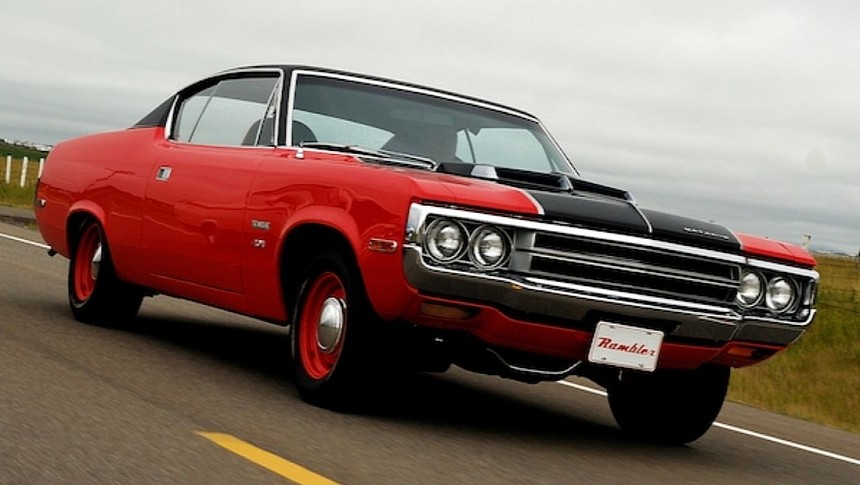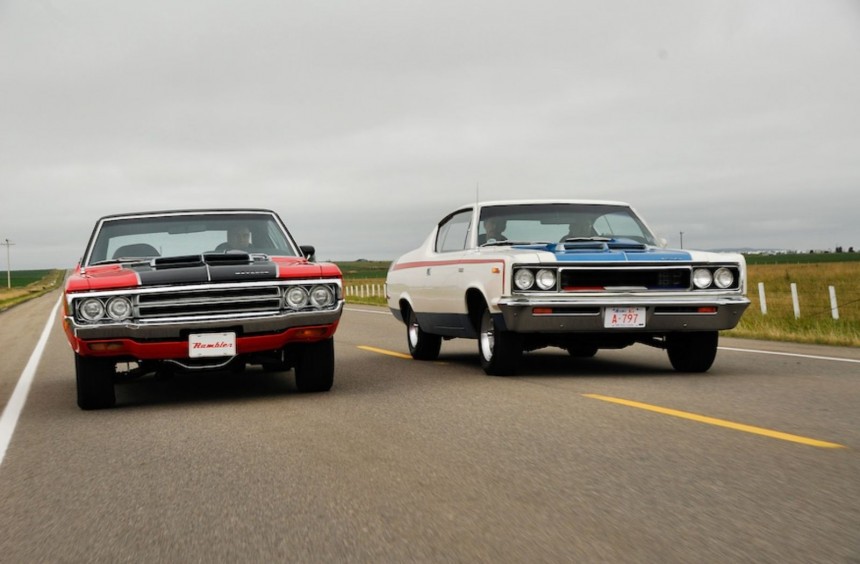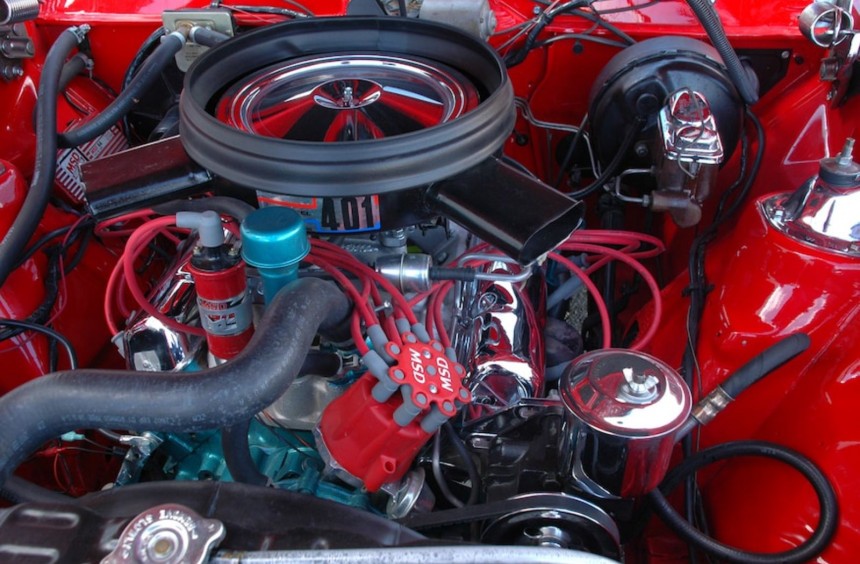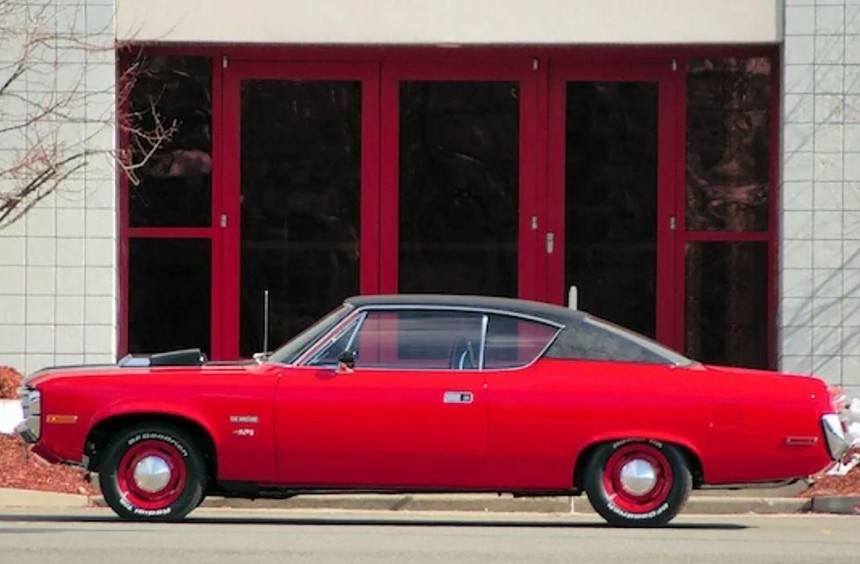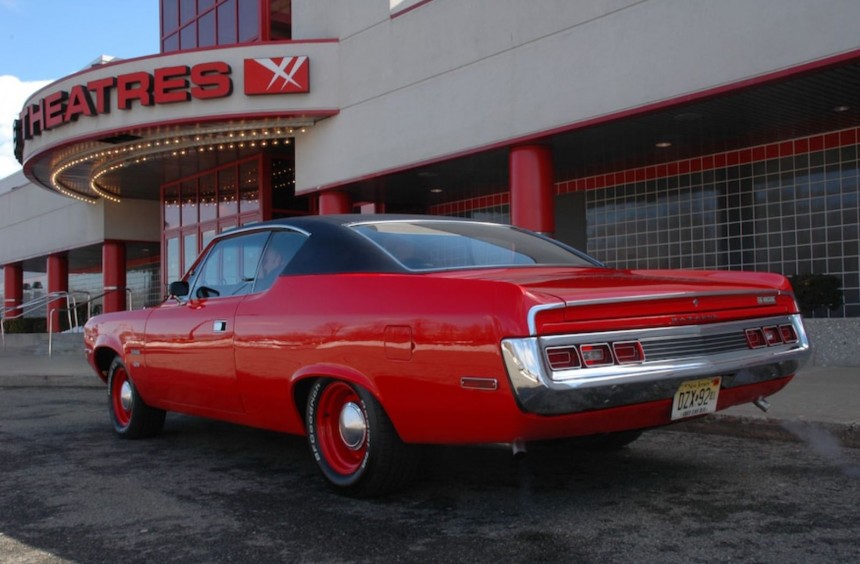The successor of the iconic Rebel-based model with the same awesome name, the 1971 Machine, was a high-performance intermediate forced to fly under the radar by rising insurance costs.
Since its inception in 1954, the American Motors Corporation has managed to compete with Detroit's Big Three even with smaller facilities, fewer resources, and less manpower.
It did so by offering cheap, good-quality vehicles with features like adjustable front seat backrests or standard disc brakes (on select models).
By the mid-1960s, the American automotive industry saw the rise in popularity of high-performance models, which we now call muscle cars.
At first, AMC was slow to adjust to this new trend, but by the decade's dawn, its lineup featured some high-powered versions of otherwise mundane rides.
The first legitimate AMC muscle car (or super car, as the segment was called back then) hit the streets in 1969.
Developed in partnership with Hurst Performance, the S/C Rambler came with a 315-hp 390-ci (6.4 liters) V8 taken from the sporty AMX, offering performance enthusiasts a cheaper alternative to similar Big Three models.
The one-year-only "Scrambler" (as it was nicknamed) was a success for AMC, prompting the company to introduce a similar model for the 1970 model year.
Based on the larger, mid-size Rambler platform, the new AMC muscle car was equipped with many performance-oriented goodies, including the 390 mill, beefed up with special heads, a hotter cam, and redesigned headers.
Capable of spitting out 340 hp and 430 lb-ft (583 Nm) of twist, the upgraded V8 made the new model AMC's most potent street car.
It also featured a patriotic paint scheme and one of the coolest names ever given to a muscle car: The Machine.
During the 1970 model year, which saw the introduction of some of the most epic muscle cars ever built, AMC managed to sell 2,326 Machines.
Though that figure wasn't outstanding compared to how many performance intermediates Ford, Chrysler, and GM had sold in 1971, it was an impressive feat for AMC.
The Machine was discontinued after the 1971 model year, as the Rebel was replaced by an updated intermediate called Matador, but the company didn't give up on the muscle car recipe.
However, skyrocketing insurance premiums and tighter emission regulations meant that AMC had to improvise, so instead of a stand-alone model, the Matador got an exciting optional package.
As mentioned earlier, stricter emission regulations and the clampdown of insurance companies on high-powered muscle cars meant that American carmakers had to reduce output and improvise.
To keep performance enthusiasts interested in their products and deliver a powerful intermediate, AMC cooked up the Machine Go package for the Matador range.
Though it didn't benefit from any form of advertising to keep insurance companies from demanding a higher premium, the package added most of the performance hardware found on the 1970 Rebel Machine.
The list of goodies included power disc front brakes, heavy-duty springs, shocks, anti-roll bars on both ends, and the Kelsey-Hayes five-spoke wheels wrapped in Goodyear PolyGlas white-lettered tires that the 1971 Machine stood on.
The only item from the previous AMC muscle car not included in this special package was the Twin-Grip limited-slip diff with 3.91 gears. However, potential customers could add it to their Matador Machines for an extra fee.
The Machine Go package was available only for the two-door hardtop Matador equipped with either the 285-hp, four-barrel carb 360-ci (5.9 liters) or the 330-hp, 401-ci (6.6 liters) V8 option.
It added $373 to the base price of a 360-powered Matador and $461 to the 401-equipped cars, which was a great deal. For comparison, the powerful HEMI option available on the Mopar intermediates cost nearly $1,000 that year.
When equipped with the 401, the Matador Machine was no Mopar slayer, yet it could run the quarter mile in a more-than-respectable 14.4 seconds.
While performance was on par with its predecessor, the new Machine didn't stand out from the crowd of Matador two-door hardtops, which made it a sleeper.
AMC offered no special paint, decals, badging, or flashy interior upgrades, so, apart from the Machine wheels, this potent muscle car looked like any other two-door Matador.
Because it lacked a muscle car identity and the company purposely omitted to advertise it as such, the Matador Machine flew under the radar during the 1971 model year, after which it was discontinued.
Though no official production numbers have survived (Chrysler got rid of them after it acquired AMC), it's estimated that only 40 to 60 two-door Matador coupes were equipped with the Machine Go package.
Of those cars, only one fully documented example is known to have survived. It was found in a deplorable state by Brad Denning of Summit, New Jersey, back in the late-1990s
Now fully restored, the 401-equipped car lacks its original wheels and has some period-incorrect items like "The Machine" stickers, a scoop, and black stripes on the hood.
Despite these inaccuracies, no other Matador Machines have surfaced in recent years, making Denning's ride the rarest AMC muscle car on the planet.
It did so by offering cheap, good-quality vehicles with features like adjustable front seat backrests or standard disc brakes (on select models).
By the mid-1960s, the American automotive industry saw the rise in popularity of high-performance models, which we now call muscle cars.
At first, AMC was slow to adjust to this new trend, but by the decade's dawn, its lineup featured some high-powered versions of otherwise mundane rides.
The first legitimate AMC muscle car (or super car, as the segment was called back then) hit the streets in 1969.
Developed in partnership with Hurst Performance, the S/C Rambler came with a 315-hp 390-ci (6.4 liters) V8 taken from the sporty AMX, offering performance enthusiasts a cheaper alternative to similar Big Three models.
The one-year-only "Scrambler" (as it was nicknamed) was a success for AMC, prompting the company to introduce a similar model for the 1970 model year.
Big shoes to fill
Capable of spitting out 340 hp and 430 lb-ft (583 Nm) of twist, the upgraded V8 made the new model AMC's most potent street car.
It also featured a patriotic paint scheme and one of the coolest names ever given to a muscle car: The Machine.
During the 1970 model year, which saw the introduction of some of the most epic muscle cars ever built, AMC managed to sell 2,326 Machines.
Though that figure wasn't outstanding compared to how many performance intermediates Ford, Chrysler, and GM had sold in 1971, it was an impressive feat for AMC.
The Machine was discontinued after the 1971 model year, as the Rebel was replaced by an updated intermediate called Matador, but the company didn't give up on the muscle car recipe.
However, skyrocketing insurance premiums and tighter emission regulations meant that AMC had to improvise, so instead of a stand-alone model, the Matador got an exciting optional package.
The Machine Go package
To keep performance enthusiasts interested in their products and deliver a powerful intermediate, AMC cooked up the Machine Go package for the Matador range.
Though it didn't benefit from any form of advertising to keep insurance companies from demanding a higher premium, the package added most of the performance hardware found on the 1970 Rebel Machine.
The list of goodies included power disc front brakes, heavy-duty springs, shocks, anti-roll bars on both ends, and the Kelsey-Hayes five-spoke wheels wrapped in Goodyear PolyGlas white-lettered tires that the 1971 Machine stood on.
The only item from the previous AMC muscle car not included in this special package was the Twin-Grip limited-slip diff with 3.91 gears. However, potential customers could add it to their Matador Machines for an extra fee.
A genuine muscle car sleeper
It added $373 to the base price of a 360-powered Matador and $461 to the 401-equipped cars, which was a great deal. For comparison, the powerful HEMI option available on the Mopar intermediates cost nearly $1,000 that year.
When equipped with the 401, the Matador Machine was no Mopar slayer, yet it could run the quarter mile in a more-than-respectable 14.4 seconds.
While performance was on par with its predecessor, the new Machine didn't stand out from the crowd of Matador two-door hardtops, which made it a sleeper.
AMC offered no special paint, decals, badging, or flashy interior upgrades, so, apart from the Machine wheels, this potent muscle car looked like any other two-door Matador.
Only one is known to have survived
Though no official production numbers have survived (Chrysler got rid of them after it acquired AMC), it's estimated that only 40 to 60 two-door Matador coupes were equipped with the Machine Go package.
Of those cars, only one fully documented example is known to have survived. It was found in a deplorable state by Brad Denning of Summit, New Jersey, back in the late-1990s
Now fully restored, the 401-equipped car lacks its original wheels and has some period-incorrect items like "The Machine" stickers, a scoop, and black stripes on the hood.
Despite these inaccuracies, no other Matador Machines have surfaced in recent years, making Denning's ride the rarest AMC muscle car on the planet.
